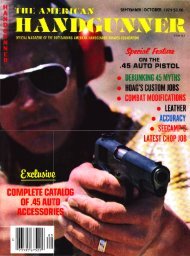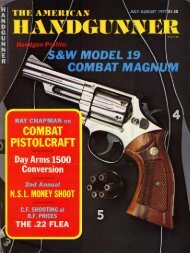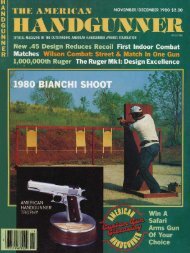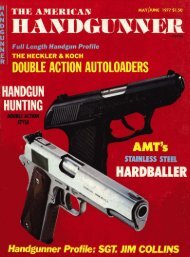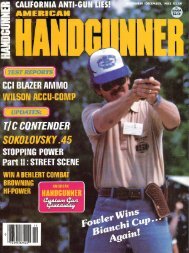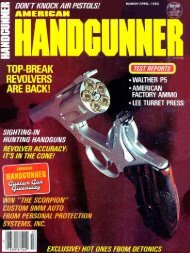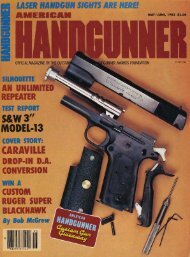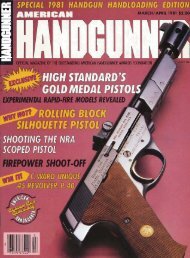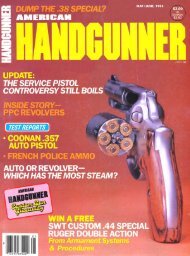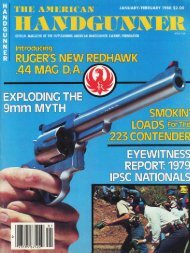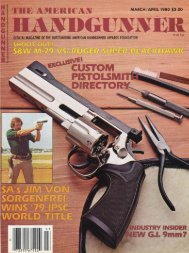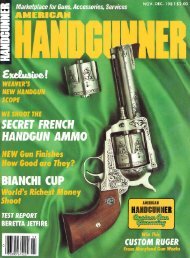In Re~o/~e"sBy Claud S. HamiltonBarrel sel up in lathe ready 10 belurned down .003 for Ihe nexllesl shool.26The gap between the forward face ofthe cylinder and the barrel shank is asmuch a part of revolvers as two legs are ofa man. Oh, there have been efforts to overcomeit as a problem-most notably theold Nagant revolver made in Russia andEurope in which the cylinder actuallymoved forward to enclose a tapered portionof the barrel shank at the moment offiring-but they have proven impractical.Today we tend to rely on fine tolerances tominimize the problems ofgas loss and sidesplatter associated with the gap.Most experienced revolver shooters areaware of the barrel gap and know that it isone ofa number ofelements which tend tocause wide variations in the muzzle velocities.developed by even identical revolvers.I say we know it is one because recentSpeer research has identified a number ofother variables which also enter into revolvervelocity variations. Some of theseare bullet length, weight and diameter.chamber throat size and the type anddepth of rifling. But have you ever wonderedjust how much of a velocity variationdiffering barrel gaps cause?While modern revolver barrel gaps varysome I'd expect a quality gun not extensivelyworn to mike somewhere between.001 and .008 inches. Haywood Nelms, afine young gunsmith from Fairfax, Virginia,fits revolvers that he builds or repairsto .003 inches since he considers thisa good compromise between gas loss andthe possible jamming which can occur ifthe gap ~s too small. What happens in thiscase is that combustion residue and bulletmetal shavings tend to build up at the gapand, in time, can cause cylinder and barrelshank to make contact and drag againstone another. Other well known gunsmithswho built guns for competition use inwhich large numbers of rounds may befired before cleaning sometimes advocategaps of .006 inches. All to whom I havespoken seem to agree that .008 is aboutmaximum.Recently I managed through the kindnessof a friend on Detroit's fine PoliceDepartment to secure a real gem-a Smith(Continued on page 48)AMERICAN HANDGUNNER· JULY/AUGUST <strong>1979</strong>
SILUETAS(Continuedfrom page 24)my satisfaction this year that that's the waythe cases are gonna go. It's still gonna be acompromise about going too small anddoing some target damage. Another reasonfor the popularity of the smaller casesand bullets is that many a woman willshoot her husband's gun and do well, withthese calibers."Phil: "You got any general thoughts you'dlike to leave us with?"Skip: "Yes, I think this sport has a lot incommon with outboard racing in the factthat you can talk to anybody and they'revery easy-going competitors. This makesthis sport what it is, it'll make the sportgrow. It's a family sport and a spectatorsport. I believe this sport will fulfill the potentialit offers from the satisfaction ofshooting these things and watching themgo down and having a good timewith the people you're ~with." ~Coming•••Next IssueTHE .45 AUTONOW ••• THERE'S A NEW GAME IN TOWNThe National Marksman Sports Societyis new. Starting in <strong>1979</strong>, theNMSS will be conducting P.P.c. typematches in nearly every state. Thesematches will be open to civilians, militaryand law enforcement personnel. ALLWILL BE ALLOWED TO COMPETE. Itwill be open to both automatic and revolvershooters on different relays.Designed by such champion shooters asJim Collins, James -McNally, and TonyBorgese, the NATIONAL MARKSMANCourse has the same basic P.P.c. theorybehind the sport, but the progressive ideasare new. A few of the changes are:*1) Civilians are allowed to shoot in aseparate category with police andmilitary.*2) Having a National classificationsystem that breaks the masters intotwo classes; Master/Grand Master. with National records, kept forthem as well as all other classes.*3) Weapons:Allowing auto's on a separate relaywith separate classification cards.However, autos and revolvers mustshoot on different relays.*4) The Course:Match 1 -300Match II-300Total-600Match III: Repeat of above-Possible Match IIScore-600Total Match Course Possible Score:1200 points*5) State Championships beginning in1980 can be entered by anyone, butonly won by shooters from thatstate.*6) National Championships begin in1980 and will be shot by regions onthe same day, time, etc., and whenthe smoke clears, there are regionalchamps as well as a NationalChampion.*7) Members of Police Marksman Associationcan shoot the NATIONAL MARKSMAN Coursewithout having to join NMSS. It'sone of their benefits.Further details on registered and approvedmatches, rules and regulations, andother courses offire details and provided inthe National Marksman Rule Book-availableby sending $1.00 to cover handlingcosts to: The National Marksman SportsSociety, P.O. Box 4747, Montgomery, AL36101, or call 205-262-5762.............................................••••.......•.ADDRESSAMERICAN HANDGUNNER591 Camino Reina. San Diego, CA 92108Please send __ copy(ies} of HISTORY OF SMITH &WESSON. Enclosed is $15.95 for each book plus $1.00for postage and handling per copy.NAMEHISTORY OFSMITH & WESSONby Roy G. JinksPresented for the first time are facts,production information, and data on variationsand modifications of all post-1945 SMITH &WESSON firearms, information necessary to everyS & W gun collector. Written by SMITH &WESSON authority Roy G. Jinks, this all neWbook carefullydetails the evolution of the companyand step-by-step, describes the development ofeach of their firearms from 1852 through andincluding 1977. Send $15.95 plus $1.00 forpostage and handling for< this renowned standard.DEPT48- H7CITYSTATECa. residents add 6% sales taxZIPAMERICAN HANDGUNNER . JULY / AUGUST <strong>1979</strong> 27



